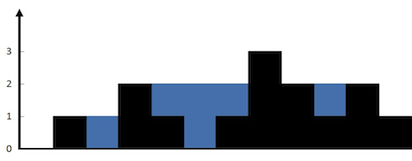面试经典算法题44-接雨水
公众号:阿Q技术站
LeetCode.42
问题描述
给定 n 个非负整数表示每个宽度为 1 的柱子的高度图,计算按此排列的柱子,下雨之后能接多少雨水。
示例 1:

输入:height = [0,1,0,2,1,0,1,3,2,1,2,1]
输出:6
解释:上面是由数组 [0,1,0,2,1,0,1,3,2,1,2,1] 表示的高度图,在这种情况下,可以接 6 个单位的雨水(蓝色部分表示雨水)。
示例 2:
输入:height = [4,2,0,3,2,5]
输出:9
思路
-
首先,找到每个柱子能接的雨水量。
我们可以观察到,每个柱子上方能够存储的雨水量取决于该柱子左侧最高柱子的高度(left_max)和右侧最高柱子的高度(right_max)中较小的那个。这是因为雨水的高度不能超过两侧最高柱子中较小的那个。 -
为了找到每个柱子左侧和右侧的最高柱子,我们可以使用两个辅助数组来保存这些信息。
一个数组left_max,用于保存每个柱子左侧最高柱子的高度。从左向右遍历数组,更新left_max[i]为max(height[i], left_max[i - 1]),其中height[i]是当前柱子的高度。同样,另一个数组
right_max用于保存每个柱子右侧最高柱子的高度。从右向左遍历数组,更新right_max[i]为max(height[i], right_max[i + 1]),其中height[i]是当前柱子的高度。 -
遍历每个柱子,计算该柱子能接的雨水量。
对于每个柱子,其能接的雨水量为min(left_max[i], right_max[i]) - height[i],其中height[i]是当前柱子的高度。如果该值为正,则说明当前柱子能够接到雨水,将其累加到总雨水量中。 -
返回总雨水量作为结果。
图解
+-------------------------+
| 开始执行程序 |
+-------------------------+
|
v
+------------------------------------------------------+
| 初始化变量 |
| left_max = [0, 0, 0, 0, 0, 0, 0, 0, 0, 0, 0, 0] |
| right_max = [0, 0, 0, 0, 0, 0, 0, 0, 0, 0, 0, 0] |
| total_water = 0 |
+------------------------------------------------------+
|
v
+----------------------------------+
| 计算 left_max |
| left_max[0] = 0 |
| left_max[1] = max(0, 1) = 1 |
| left_max[2] = max(1, 0) = 1 |
| left_max[3] = max(1, 2) = 2 |
| left_max[4] = max(2, 1) = 2 |
| left_max[5] = max(2, 0) = 2 |
| left_max[6] = max(2, 1) = 2 |
| left_max[7] = max(2, 3) = 3 |
| left_max[8] = max(3, 2) = 3 |
| left_max[9] = max(3, 1) = 3 |
| left_max[10] = max(3, 2) = 3 |
| left_max[11] = max(3, 1) = 3 |
+----------------------------------+
|
v
+-----------------------------------+
| 计算 right_max |
| right_max[11] = 0 |
| right_max[10] = max(0, 1) = 1 |
| right_max[9] = max(1, 2) = 2 |
| right_max[8] = max(2, 1) = 2 |
| right_max[7] = max(2, 3) = 3 |
| right_max[6] = max(3, 1) = 3 |
| right_max[5] = max(3, 2) = 3 |
| right_max[4] = max(3, 1) = 3 |
| right_max[3] = max(3, 2) = 3 |
| right_max[2] = max(3, 1) = 3 |
| right_max[1] = max(3, 2) = 3 |
| right_max[0] = max(3, 0) = 3 |
+-----------------------------------+
|
v
+-----------------------------------------------------------------+
| 计算总雨水量 |
| i = 0: water = min(3, 0) - 0 = 0 |
| i = 1: water = min(1, 3) - 1 = 0 |
| i = 2: water = min(1, 3) - 0 = 1 |
| i = 3: water = min(2, 3) - 2 = 0 |
| i = 4: water = min(2, 3) - 1 = 1 |
| i = 5: water = min(2, 3) - 0 = 2 |
| i = 6: water = min(2, 3) - 1 = 1 |
| i = 7: water = min(3, 3) - 3 = 0 |
| i = 8: water = min(3, 3) - 2 = 1 |
| i = 9: water = min(3, 2) - 1 = 1 |
| i = 10: water = min(3, 1) - 2 = 0 |
| i = 11: water = min(3, 0) - 1 = 0 |
| 总雨水量 = 0 + 0 + 1 + 0 + 1 + 2 + 1 + 0 + 1 + 1 + 0 + 0 = 6 |
+-----------------------------------------------------------------+
|
v
+-------------------------+
| 输出结果 |
| 能接的雨水量:6 |
+-------------------------+
参考代码
C++
#include <iostream>
#include <vector>
int trap(std::vector<int>& height) {
int n = height.size();
if (n == 0) return 0;
std::vector<int> left_max(n); // 保存每个柱子左侧最高柱子的高度
std::vector<int> right_max(n); // 保存每个柱子右侧最高柱子的高度
// 初始化左侧最高柱子数组
left_max[0] = height[0];
for (int i = 1; i < n; ++i) {
left_max[i] = std::max(left_max[i - 1], height[i]);
}
// 初始化右侧最高柱子数组
right_max[n - 1] = height[n - 1];
for (int i = n - 2; i >= 0; --i) {
right_max[i] = std::max(right_max[i + 1], height[i]);
}
int total_water = 0; // 总雨水量
// 计算每个柱子能接的雨水量
for (int i = 0; i < n; ++i) {
int water = std::min(left_max[i], right_max[i]) - height[i];
if (water > 0) {
total_water += water;
}
}
return total_water;
}
int main() {
std::vector<int> height = {0,1,0,2,1,0,1,3,2,1,2,1};
int result = trap(height);
std::cout << "能接的雨水量:" << result << std::endl;
return 0;
}
Java
import java.util.Arrays;
public class Main {
public static int trap(int[] height) {
int n = height.length;
if (n == 0) return 0;
int[] left_max = new int[n]; // 保存每个柱子左侧最高柱子的高度
int[] right_max = new int[n]; // 保存每个柱子右侧最高柱子的高度
// 初始化左侧最高柱子数组
left_max[0] = height[0];
for (int i = 1; i < n; ++i) {
left_max[i] = Math.max(left_max[i - 1], height[i]);
}
// 初始化右侧最高柱子数组
right_max[n - 1] = height[n - 1];
for (int i = n - 2; i >= 0; --i) {
right_max[i] = Math.max(right_max[i + 1], height[i]);
}
int total_water = 0; // 总雨水量
// 计算每个柱子能接的雨水量
for (int i = 0; i < n; ++i) {
int water = Math.min(left_max[i], right_max[i]) - height[i];
if (water > 0) {
total_water += water;
}
}
return total_water;
}
public static void main(String[] args) {
int[] height = {0,1,0,2,1,0,1,3,2,1,2,1};
int result = trap(height);
System.out.println("能接的雨水量:" + result);
}
}
Python
def trap(height):
n = len(height)
if n == 0:
return 0
left_max = [0] * n # 保存每个柱子左侧最高柱子的高度
right_max = [0] * n # 保存每个柱子右侧最高柱子的高度
# 初始化左侧最高柱子数组
left_max[0] = height[0]
for i in range(1, n):
left_max[i] = max(left_max[i - 1], height[i])
# 初始化右侧最高柱子数组
right_max[n - 1] = height[n - 1]
for i in range(n - 2, -1, -1):
right_max[i] = max(right_max[i + 1], height[i])
total_water = 0 # 总雨水量
# 计算每个柱子能接的雨水量
for i in range(n):
water = min(left_max[i], right_max[i]) - height[i]
if water > 0:
total_water += water
return total_water
height = [0,1,0,2,1,0,1,3,2,1,2,1]
result = trap(height)
print("能接的雨水量:", result)























 215
215

 被折叠的 条评论
为什么被折叠?
被折叠的 条评论
为什么被折叠?








